10 Questions on Phosphorus Management
There are fundamental truths about soil biology, soil chemistry, and plant development that, at best, are not addressed by many conventional farming methods. At worst, they work in contrast to how soils and plants naturally perform.
The following 10 Questions on Phosphorus Management may open some new thinking about your fertilizer budget. Spend some time with these questions and review them with your current fertilizer dealer or agronomist. After that, we invite you to discuss these questions and effective ways to improve nutrient use efficiency with your local Maximum Farming System Associate. Contact us to get in touch with an Associate near you.
a. P1 is a small fraction of total soil P. It is the fraction that becomes available in solution.
b. P2 represents the active pool that can come into solution throughout the growing season; largely through the action of soil microbes and root-colonizing mycorrhizal fungi.
c. Phosphorus pools cycle up to 500 times a season; a dynamic driven largely by both soil chemistry and soil biology.
d. In most soils, P is available in ample supplies for plants to function. Unfortunately, the P from dry spread or soil P isn’t adequately available through early developmental stages that determine kernel number.
e. P ions do not move in the soil. Roots and mycorrhizal hyphae (the beneficial fungi allowing plants to draw nutrients and water from the soil) must grow to access P nutrition.
f. Starter fertilizers must be in-furrow for maximum efficiency, and they must be formulated to not harm young roots. At the same time, rates must be high enough to supply the phosphorus needed to maximize yield potential. Few products provide that balance.1
a. Phosphorus is present in all cells. It forms the backbone of DNA and RNA, and it is essential for many processes, including good respiration and energy transfer.2
b. Without adequate P supply, plant growth is diminished, maturity is delayed, and yield is reduced.
c. The seed has adequate P to keep a young plant alive before it can use soil P, but it isn’t enough to maximize early growth and, subsequently, maximize yield.3
a. Dry fertilizer P is largely derived from rock phosphate. Through acid extraction, the P (a negative charge) is separated from Ca (a double positive charge).
b. The P ions released by dry fertilizer after a rain will soon chemically bind with soil Ca ions under typical field conditions.
c. Soil Ca levels of 75% to 85% exchangeable cations help ensure good soil flocculation and air-water balance after rainfall or irrigation.
a. In natural prairies, soil P is abundant and optimally recycled. Light textured, i.e. sandy, soils will have around 400 pounds of P while fine-textured, clay soils will have around 10,000 pounds of P in the top 6 to 8 inches.4
b. While most soil P is not readily available for root uptake, it is more readily accessed by soil microbes, including diverse soil bacteria and root-colonizing mycorrhizal fungi.
c. By feeding and supporting soil microbes with root exudates (beneficial secretions of amino acids, sugars, organic acids and other substances), plants can access abundant P in proportion to soil microbial activity.
d. Plant roots access soil P directly by working with mycorrhizal fungi and indirectly by supporting soil bacterial activity with carbon-rich root exudates.
e. Plants are the ultimate recyclers. As plants die off, the roots and shoots decay and return phosphorus to the soil, enriching soluble and microbial pools throughout the growing season. (Figure 1)
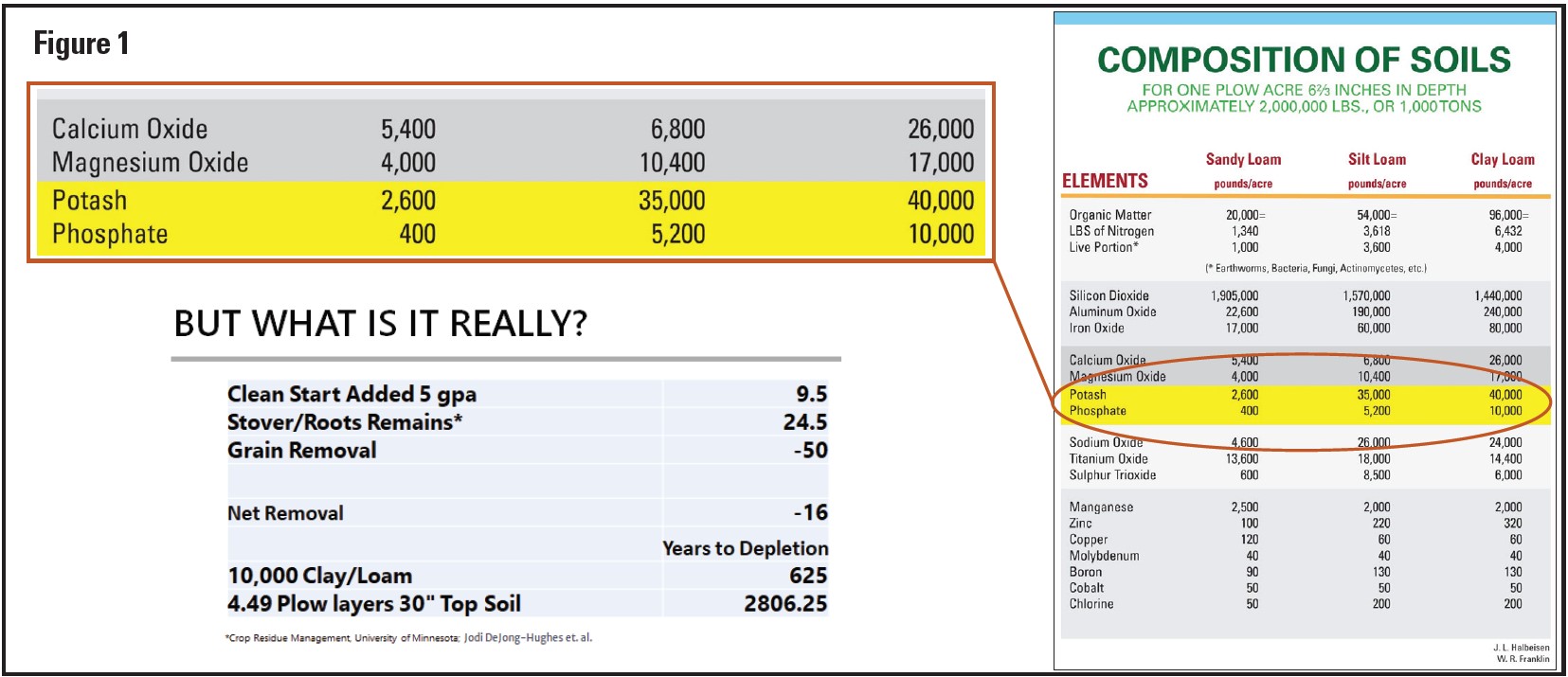
a. The fact is there is plenty of P naturally available to grow a crop in most soils (Figure 2). Farmers must increase P availability in the root zone, in a safe form and rate, when the crop really needs it to maximize yield potential.
b. Excess manure or dry phosphorus fertilizer applications may increase soil test P values, but crop availability in the right form, right place or at the right time for maximum yield isn’t guaranteed.
c. CHS, a manufacturer of dry phosphorus, says in the best soil conditions, only 20% of dry phosphorus is used by a corn crop. This means at least 80% of applied P does not impact yield.5
d. The lack of correlation between P levels and yield in most fields means something else is driving yield potential and farmers are likely spending more money on P than necessary.

a. Excessive application with both dry and liquid P fertilizer products can limit beneficial microbial activities, especially the beneficial interaction between roots an mycorrhizal fungi.
b. Salt content drives seed safety with starter fertilizers.
c. To compensate for crop safety, in furrow starter rates are often cut to levels that don’t support optimal early growth nor do they supply adequate phosphorus to maximize kernel count.
d. As a remedy to avoid root damage, many agronomists recommend higher rates of P placed 2 inches from the row. However, roots won’t access most of that fertilizer P until they grow into it, and that is often after the period when kernel number is affected by P.
e. If other problems like sidewall compaction exist, the root system will be restricted and access to nutrient P will be limited.
a. Over application of P fertilizers can reduce exchangeable Ca levels, which can negatively impact a soil’s air-water balance and, thus, reduce yield potential.
b. Too much P can limit root uptake of key nutrients, particularly iron and zinc. This is now recognized as a preventable problem that sometimes requires farmers to make additional input applications.6
c. Very high soil P levels also can suppress mycorrhizal colonization of roots. This reduces the mycorrhizae’s ability to protect the crop against drought, nutrient deficiencies, and root disease.
a. Generally, a 200 bu corn crop and a 90 bu soybean crop each contain about 70# of phosphorus (P2O5 equivalents) in harvestable grain.
b. Annual crop removal of P is often very close to the rate at which mineral P is released and taken up by soil life throughout the soil profile, so supplemental additions are only needed to support growth when soil biology is largely inactive.
c. The commonly recommended replacement rate of 150# of dry P fertilizer that contains 68-78# P2O5 is often unnecessary.
d. In the Maximum Farming System, sufficient supplemental P is provided in furrow with Clean Start. However, years of soil test data indicate that a minority of fields can benefit from some additional P, ideally provided as fall manure and/or just 100# of dry P fertilizer.
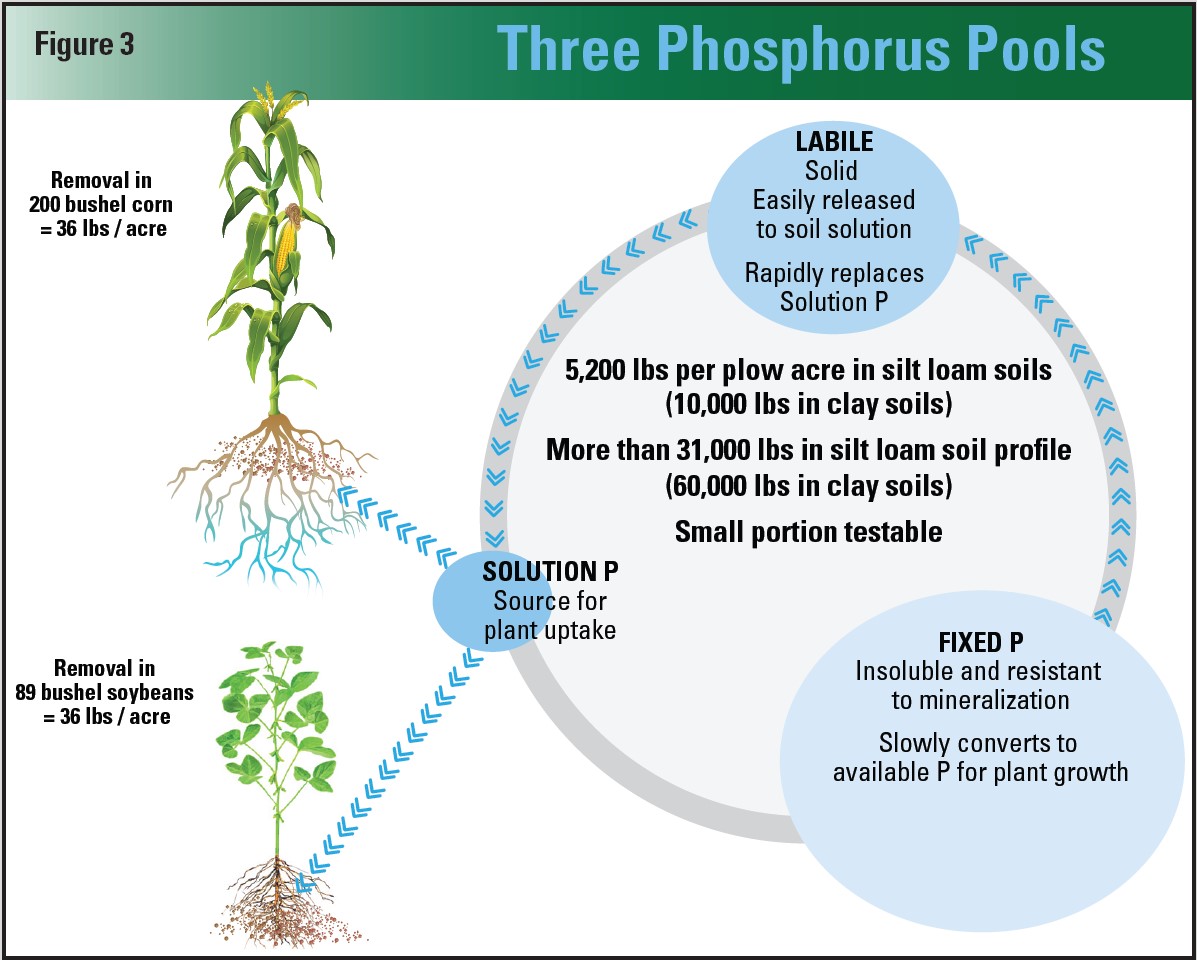
a. The cost of 70# of P2O5 (of which only 14# is immediately available to the crop) in April 2022 was $80.33 per acre, more than double of what it was in April 2019.7
b. If 80% of dry spread isn’t available in the best soil conditions, as stated by CHS, the plant-available phosphorus from a 5 gpa in-furrow application of Clean Start (which provides an optimally formulated 9.9# of P2O5) is much more cost efficient.
c. Even if more than 20% of a dry application becomes available, it still must get into the root zone to be used by the plant. Just remember that P is practically immobile in soils because it precipitates readily when it contacts dissolved Ca in soils.
d. The bottom line is that dry spread P fertilizer costs more and delivers less than a typical in-furrow application of Clean Start.
a. Place a nutrient-available form of P in the seed trench where roots can easily access it.
b. Balance the right rates to deliver the needed phosphorus that stimulates vigorous crop growth.
c. Soil and most fertilizer P become available during the growing season in a dynamic way. In fact, plant availability status of every soluble P ion can change up to 500 times a season.8
d. In furrow Clean Start at optimal rates (typically 4 to 6 gal/ac) provides soil-specific supplemental P in the right form, rate, placement, and timing to support optimal crop growth.
e. Properly blending Clean Start with Kick-Off and GroZyme provides a synergistic formulation that works to stimulate soil microbes, grow roots, and deliver better overall nutrient use efficiency throughout the growing season.
a. P1 is a small fraction of total soil P. It is the fraction that becomes available in solution.
b. P2 represents the active pool that can come into solution throughout the growing season; largely through the action of soil microbes and root-colonizing mycorrhizal fungi.
c. Phosphorus pools cycle up to 500 times a season; a dynamic driven largely by both soil chemistry and soil biology.
d. In most soils, P is available in ample supplies for plants to function. Unfortunately, the P from dry spread or soil P isn’t adequately available through early developmental stages that determine kernel number.
e. P ions do not move in the soil. Roots and mycorrhizal hyphae (the beneficial fungi allowing plants to draw nutrients and water from the soil) must grow to access P nutrition.
f. Starter fertilizers must be in-furrow for maximum efficiency, and they must be formulated to not harm young roots. At the same time, rates must be high enough to supply the phosphorus needed to maximize yield potential. Few products provide that balance.1
a. Phosphorus is present in all cells. It forms the backbone of DNA and RNA, and it is essential for many processes, including good respiration and energy transfer.2
b. Without adequate P supply, plant growth is diminished, maturity is delayed, and yield is reduced.
c. The seed has adequate P to keep a young plant alive before it can use soil P, but it isn’t enough to maximize early growth and, subsequently, maximize yield.3
a. Dry fertilizer P is largely derived from rock phosphate. Through acid extraction, the P (a negative charge) is separated from Ca (a double positive charge).
b. The P ions released by dry fertilizer after a rain will soon chemically bind with soil Ca ions under typical field conditions.
c. Soil Ca levels of 75% to 85% exchangeable cations help ensure good soil flocculation and air-water balance after rainfall or irrigation.
a. In natural prairies, soil P is abundant and optimally recycled. Light textured, i.e. sandy, soils will have around 400 pounds of P while fine-textured, clay soils will have around 10,000 pounds of P in the top 6 to 8 inches.4
b. While most soil P is not readily available for root uptake, it is more readily accessed by soil microbes, including diverse soil bacteria and root-colonizing mycorrhizal fungi.
c. By feeding and supporting soil microbes with root exudates (beneficial secretions of amino acids, sugars, organic acids and other substances), plants can access abundant P in proportion to soil microbial activity.
d. Plant roots access soil P directly by working with mycorrhizal fungi and indirectly by supporting soil bacterial activity with carbon-rich root exudates.
e. Plants are the ultimate recyclers. As plants die off, the roots and shoots decay and return phosphorus to the soil, enriching soluble and microbial pools throughout the growing season. (Figure 1)

a. The fact is there is plenty of P naturally available to grow a crop in most soils (Figure 2). Farmers must increase P availability in the root zone, in a safe form and rate, when the crop really needs it to maximize yield potential.
b. Excess manure or dry phosphorus fertilizer applications may increase soil test P values, but crop availability in the right form, right place or at the right time for maximum yield isn’t guaranteed.
c. CHS, a manufacturer of dry phosphorus, says in the best soil conditions, only 20% of dry phosphorus is used by a corn crop. This means at least 80% of applied P does not impact yield.5
d. The lack of correlation between P levels and yield in most fields means something else is driving yield potential and farmers are likely spending more money on P than necessary.

a. Excessive application with both dry and liquid P fertilizer products can limit beneficial microbial activities, especially the beneficial interaction between roots an mycorrhizal fungi.
b. Salt content drives seed safety with starter fertilizers.
c. To compensate for crop safety, in furrow starter rates are often cut to levels that don’t support optimal early growth nor do they supply adequate phosphorus to maximize kernel count.
d. As a remedy to avoid root damage, many agronomists recommend higher rates of P placed 2 inches from the row. However, roots won’t access most of that fertilizer P until they grow into it, and that is often after the period when kernel number is affected by P.
e. If other problems like sidewall compaction exist, the root system will be restricted and access to nutrient P will be limited.
a. Over application of P fertilizers can reduce exchangeable Ca levels, which can negatively impact a soil’s air-water balance and, thus, reduce yield potential.
b. Too much P can limit root uptake of key nutrients, particularly iron and zinc. This is now recognized as a preventable problem that sometimes requires farmers to make additional input applications.6
c. Very high soil P levels also can suppress mycorrhizal colonization of roots. This reduces the mycorrhizae’s ability to protect the crop against drought, nutrient deficiencies, and root disease.
a. Generally, a 200 bu corn crop and a 90 bu soybean crop each contain about 70# of phosphorus (P2O5 equivalents) in harvestable grain.
b. Annual crop removal of P is often very close to the rate at which mineral P is released and taken up by soil life throughout the soil profile, so supplemental additions are only needed to support growth when soil biology is largely inactive.
c. The commonly recommended replacement rate of 150# of dry P fertilizer that contains 68-78# P2O5 is often unnecessary.
d. In the Maximum Farming System, sufficient supplemental P is provided in furrow with Clean Start. However, years of soil test data indicate that a minority of fields can benefit from some additional P, ideally provided as fall manure and/or just 100# of dry P fertilizer.

a. The cost of 70# of P2O5 (of which only 14# is immediately available to the crop) in April 2022 was $80.33 per acre, more than double of what it was in April 2019.7
b. If 80% of dry spread isn’t available in the best soil conditions, as stated by CHS, the plant-available phosphorus from a 5 gpa in-furrow application of Clean Start (which provides an optimally formulated 9.9# of P2O5) is much more cost efficient.
c. Even if more than 20% of a dry application becomes available, it still must get into the root zone to be used by the plant. Just remember that P is practically immobile in soils because it precipitates readily when it contacts dissolved Ca in soils.
d. The bottom line is that dry spread P fertilizer costs more and delivers less than a typical in-furrow application of Clean Start.
a. Place a nutrient-available form of P in the seed trench where roots can easily access it.
b. Balance the right rates to deliver the needed phosphorus that stimulates vigorous crop growth.
c. Soil and most fertilizer P become available during the growing season in a dynamic way. In fact, plant availability status of every soluble P ion can change up to 500 times a season.8
d. In furrow Clean Start at optimal rates (typically 4 to 6 gal/ac) provides soil-specific supplemental P in the right form, rate, placement, and timing to support optimal crop growth.
e. Properly blending Clean Start with Kick-Off and GroZyme provides a synergistic formulation that works to stimulate soil microbes, grow roots, and deliver better overall nutrient use efficiency throughout the growing season.
1. What are the main things I need to know about phosphorus?
a. P1 is a small fraction of total soil P. It is the fraction that becomes available in solution.
b. P2 represents the active pool that can come into solution throughout the growing season; largely through the action of soil microbes and root-colonizing mycorrhizal fungi.
c. Phosphorus pools cycle up to 500 times a season; a dynamic driven largely by both soil chemistry and soil biology.
d. In most soils, P is available in ample supplies for plants to function. Unfortunately, the P from dry spread or soil P isn’t adequately available through early developmental stages that determine kernel number.
e. P ions do not move in the soil. Roots and mycorrhizal hyphae (the beneficial fungi allowing plants to draw nutrients and water from the soil) must grow to access P nutrition.
f. Starter fertilizers must be in-furrow for maximum efficiency, and they must be formulated to not harm young roots. At the same time, rates must be high enough to supply the phosphorus needed to maximize yield potential. Few products provide that balance.1
2. What does phosphorus do for the plant?
a. Phosphorus is present in all cells. It forms the backbone of DNA and RNA, and it is essential for many processes, including good respiration and energy transfer.2
b. Without adequate P supply, plant growth is diminished, maturity is delayed, and yield is reduced.
c. The seed has adequate P to keep a young plant alive before it can use soil P, but it isn’t enough to maximize early growth and, subsequently, maximize yield.3
3. Where does the dry phosphorus fertilizer we spread come from?
a. Dry fertilizer P is largely derived from rock phosphate. Through acid extraction, the P (a negative charge) is separated from Ca (a double positive charge).
b. The P ions released by dry fertilizer after a rain will soon chemically bind with soil Ca ions under typical field conditions.
c. Soil Ca levels of 75% to 85% exchangeable cations help ensure good soil flocculation and air-water balance after rainfall or irrigation.
4. How did natural prairies exist for thousands of years without any phosphorus applications?
a. In natural prairies, soil P is abundant and optimally recycled. Light textured, i.e. sandy, soils will have around 400 pounds of P while fine-textured, clay soils will have around 10,000 pounds of P in the top 6 to 8 inches.4
b. While most soil P is not readily available for root uptake, it is more readily accessed by soil microbes, including diverse soil bacteria and root-colonizing mycorrhizal fungi.
c. By feeding and supporting soil microbes with root exudates (beneficial secretions of amino acids, sugars, organic acids and other substances), plants can access abundant P in proportion to soil microbial activity.
d. Plant roots access soil P directly by working with mycorrhizal fungi and indirectly by supporting soil bacterial activity with carbon-rich root exudates.
e. Plants are the ultimate recyclers. As plants die off, the roots and shoots decay and return phosphorus to the soil, enriching soluble and microbial pools throughout the growing season. (Figure 1)
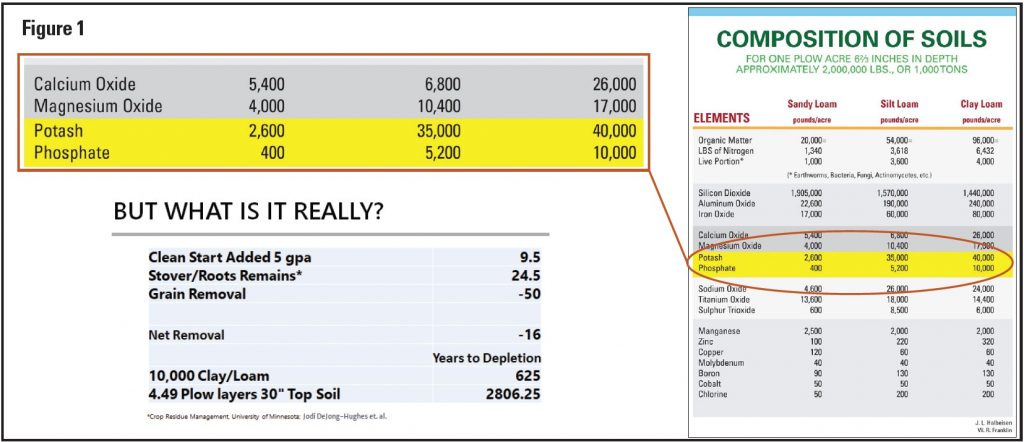
5. Can you show consistent proof that areas of the highest phosphorus soil test levels are the highest yielding areas?
a. The fact is there is plenty of P naturally available to grow a crop in most soils (Figure 2). Farmers must increase P availability in the root zone, in a safe form and rate, when the crop really needs it to maximize yield potential.
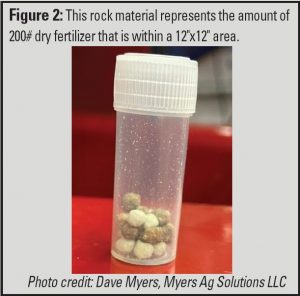
b. Excess manure or dry phosphorus fertilizer applications may increase soil test P values, but crop availability in the right form, right place or at the right time for maximum yield isn’t guaranteed.
c. CHS, a manufacturer of dry phosphorus, says in the best soil conditions, only 20% of dry phosphorus is used by a corn crop. This means at least 80% of applied P does not impact yield.5
d. The lack of correlation between P levels and yield in most fields means something else is driving yield potential and farmers are likely spending more money on P than necessary.
6. Can you over apply phosphorus?
a. Excessive application with both dry and liquid P fertilizer products can limit beneficial microbial activities, especially the beneficial interaction between roots an mycorrhizal fungi.
b. Salt content drives seed safety with starter fertilizers.
c. To compensate for crop safety, in furrow starter rates are often cut to levels that don’t support optimal early growth nor do they supply adequate phosphorus to maximize kernel count.
d. As a remedy to avoid root damage, many agronomists recommend higher rates of P placed 2 inches from the row. However, roots won’t access most of that fertilizer P until they grow into it, and that is often after the period when kernel number is affected by P.
e. If other problems like sidewall compaction exist, the root system will be restricted and access to nutrient P will be limited.
7. How does excess phosphorus affect soil health and overall soil balance?
a. Over application of P fertilizers can reduce exchangeable Ca levels, which can negatively impact a soil’s air-water balance and, thus, reduce yield potential.
b. Too much P can limit root uptake of key nutrients, particularly iron and zinc. This is now recognized as a preventable problem that sometimes requires farmers to make additional input applications.6
c. Very high soil P levels also can suppress mycorrhizal colonization of roots. This reduces the mycorrhizae’s ability to protect the crop against drought, nutrient deficiencies, and root disease.
8. What is a farmer’s net removal of phosphorus?
a. Generally, a 200 bu corn crop and a 90 bu soybean crop each contain about 70# of phosphorus (P2O5 equivalents) in harvestable grain.
b. Annual crop removal of P is often very close to the rate at which mineral P is released and taken up by soil life throughout the soil profile, so supplemental additions are only needed to support growth when soil biology is largely inactive.
c. The commonly recommended replacement rate of 150# of dry P fertilizer that contains 68-78# P2O5 is often unnecessary.
d. In the Maximum Farming System, sufficient supplemental P is provided in furrow with Clean Start. However, years of soil test data indicate that a minority of fields can benefit from some additional P, ideally provided as fall manure and/or just 100# of dry P fertilizer.
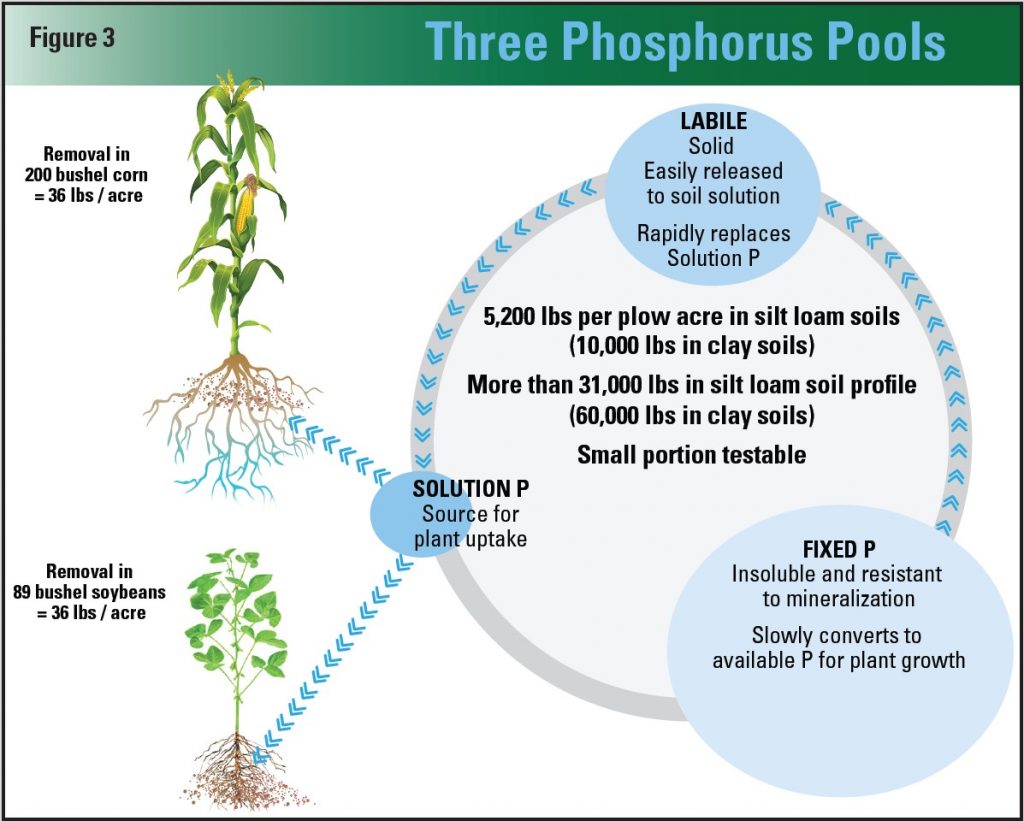
9. What is the real cost of the phosphorus fertilizer application my crops actually access?
a. The cost of 70# of P2O5 (of which only 14# is immediately available to the crop) in April 2022 was $80.33 per acre, more than double of what it was in April 2019.7
b. If 80% of dry spread isn’t available in the best soil conditions, as stated by CHS, the plant-available phosphorus from a 5 gpa in-furrow application of Clean Start (which provides an optimally formulated 9.9# of P2O5) is much more cost efficient.
c. Even if more than 20% of a dry application becomes available, it still must get into the root zone to be used by the plant. Just remember that P is practically immobile in soils because it precipitates readily when it contacts dissolved Ca in soils.
d. The bottom line is that dry spread P fertilizer costs more and delivers less than a typical in-furrow application of Clean Start.
10. What is the best way to impact yield with phosphorus?
a. Place a nutrient-available form of P in the seed trench where roots can easily access it.
b. Balance the right rates to deliver the needed phosphorus that stimulates vigorous crop growth.
c. Soil and most fertilizer P become available during the growing season in a dynamic way. In fact, plant availability status of every soluble P ion can change up to 500 times a season.8
d. In furrow Clean Start at optimal rates (typically 4 to 6 gal/ac) provides soil-specific supplemental P in the right form, rate, placement, and timing to support optimal crop growth.
e. Properly blending Clean Start with Kick-Off and GroZyme provides a synergistic formulation that works to stimulate soil microbes, grow roots, and deliver better overall nutrient use efficiency throughout the growing season.
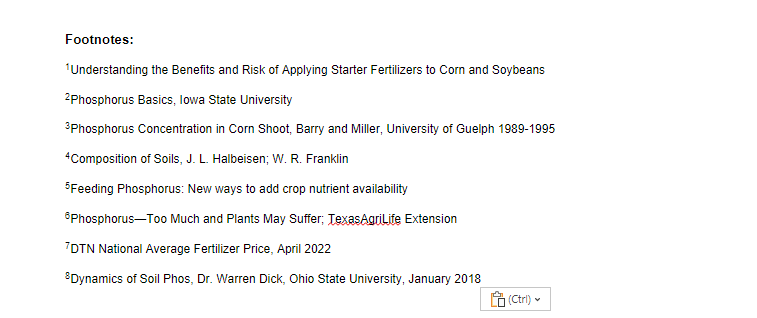
a. P1 is a small fraction of total soil P. It is the fraction that becomes available in solution.
b. P2 represents the active pool that can come into solution throughout the growing season; largely through the action of soil microbes and root-colonizing mycorrhizal fungi.
c. Phosphorus pools cycle up to 500 times a season; a dynamic driven largely by both soil chemistry and soil biology.
d. In most soils, P is available in ample supplies for plants to function. Unfortunately, the P from dry spread or soil P isn’t adequately available through early developmental stages that determine kernel number.
e. P ions do not move in the soil. Roots and mycorrhizal hyphae (the beneficial fungi allowing plants to draw nutrients and water from the soil) must grow to access P nutrition.
f. Starter fertilizers must be in-furrow for maximum efficiency, and they must be formulated to not harm young roots. At the same time, rates must be high enough to supply the phosphorus needed to maximize yield potential. Few products provide that balance.1